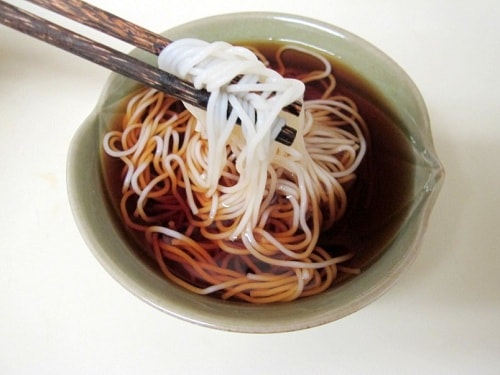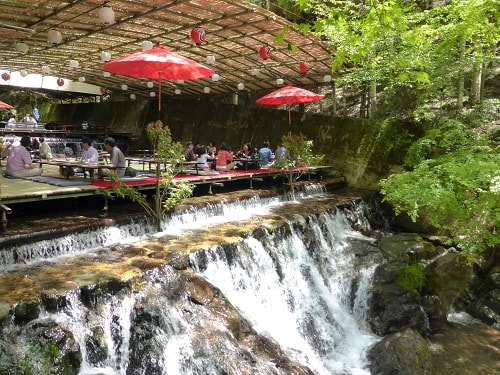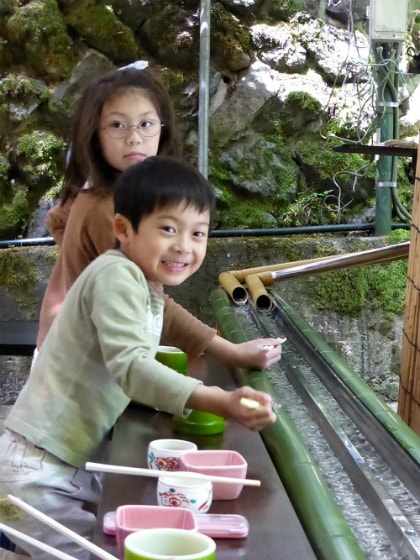Western tourists enjoy sliding noodles down a chute in Japan
Chang Tan was very excited as he slurped up the noodles he had just scooped up from the water trough, watching the noodles floating towards him, competing with the children sitting at the same table.
Chang Tan is a young man from London, England. After graduating from university, he joined an investment bank and has not had the opportunity to explore the world.. Everything changed when Chang took a long leave in early 2014 to prepare for his journey, which had yet to be named. In April 2015, Chang Tan visited Kibune village, Kyoto, Japan, and enjoyed the famous nagashi-somen bamboo-sliding noodles there.
 |
The nagashi-somen broth is typically a mix of soy sauce, fish stock, and a little sake. Photo: Julia Frost. |
Nagashi-somenis one of the traditional Japanese dishes eaten in the summer. Among them, somenis a type of thin noodle, usually served cold. It only takes a few minutes to blanch the noodles before being served in cold broth, sprinkled with green onions. "Nagashi"means to flow. Nagashi-somen is a type of somen noodle dish in which diners use chopsticks to pick up noodles and let them float down a stream of cool water flowing in a bamboo trough.
Having learned a lot about nagashi-somen, Chang decided to spend a day during his trip to Kyoto to find a famous restaurant in Kibune village that served this dish. Chang took the train from central Kyoto to Kibune, which took half an hour. The passenger compartment was crowded with countless locals carrying all kinds of professional climbing equipment, escaping the summer heat in Kyoto city. Unable to find a bus at Kibune-guchi station, Chang decided to walk to the restaurant.
 |
View of Hirobun restaurant. Photo: Ching Chong Chang. |
Chang Tan thought he would be the first customer to open Hirobun since he had left early, but there were many others already there. Chang signed up for a reservation and was given a 34th-round ticket, which he was hesitant about since the store didn't open until 11am. However, heIt was nice to see a few people waiting while the tables could seat up to 12 people at a time.
Half an hour later, the staff called Chang’s number as a Singaporean family put down their chopsticks. He eagerly sat at the table with his chopsticks ready, waiting for the noodles to float down the bamboo trough to his seat. Chang nimbly picked up a handful of noodles, dipped them in the broth, and slurped them down, all the while keeping an eye on the noodles as they floated towards him.
 |
The children at the same table were much more excited than Chang Tan. Photo: Ching Chong Chang. |
The noodle machine is very punctual, so if a customer misses a turn, the noodles will be discarded when they reach the end. Two bamboo troughs serve 7 different tables. As a courtesy, the customers at a table take turns picking up the noodles to avoid the situation where the person sitting closest to the trough gets a portion and the rest of the people go hungry.
Finally, a handful of colored noodles slid out, signaling the end of the meal. Chang put down his chopsticks and finished off his meal with mochi, feeling satisfied. His stomach was warm, and he felt ready for the climb to Kurama later.
Chang shared that it was a really great experience during his visit to Japan because people don’t often have the opportunity to play with food served in such a special way. Chang also expressed surprise that this Japanese dining model has not been commercialized in other lands, it must be an interesting culinary experience that both children and adults love.
How Japanese people enjoy nagashi-somen:
According to VNE
| RELATED NEWS |
|---|
